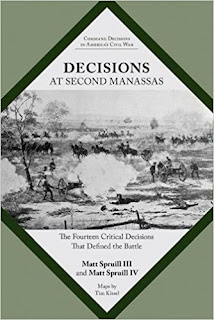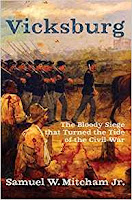[
Decisions at Second Manassas: The Fourteen Critical Decisions That Defined the Battle by Matt Spruill III & Matt Spruill IV (
University of Tennessee Press, 2018). Softcover, 41 maps, photos, appendices, notes, bibliography, index. 277 Pages. ISBN:978-1-62190-380-2. $29.95]

Matt Spruill III and Matt Spruill IV's
Decisions at Second Manassas: The Fourteen Critical Decisions That Defined the Battle is the second volume from UT Press's Command Decisions in America's Civil War series. The first book clearly laid out the novel format's underlying assumptions and definitions (see the
Decisions at Stones River review published a short time ago here on CWBA). In summary, 'critical' decisions are distinguished from merely important decisions by their fundamental altering of the "sequence and course of events" of campaigns and battles.
As seen before with
Stones River, the basic critical decision analysis structure of
Decisions at Second Manassas proceeds through five subheadings—
Situation,
Options,
Decision,
Result/Impact, and
Alternate Decision/Scenario. The first and typically the lengthiest section,
Situation describes the state of affairs at a crossroads moment in the campaign or battle. It provides readers with the background information necessary to recognize and evaluate the decision
Options (in this case, two to four in number) that immediately follow. The historical
Decision is then outlined very briefly before the
Result/Impact section recounts what happened and how those events shaped the rest of the battle and perhaps beyond. The
Situation and
Result/Impact sections quite often reference other decisions in a meaningful way, further reminding readers of their fundamental interconnectedness and the cascading consequences of critical decisions made earlier. Not present for every decision, the optional
Alternate Decision/Scenario section delves into reasonable alternative history conjecture based on choices not made.
Distinct from most narrative battle histories, the books in this series use this critical decision system of analysis as a more focused mechanism for readers "to progress from an understanding of “what happened” to “why events happened” as they did." The professional military background of the co-authors undoubtedly informs this new approach. For the series as a whole, critical choices will span areas of strategy, operations, tactics, organization, logistics, and personnel. The fourteen critical Second Manassas decisions are slotted within three of those categories: organizational (1), operational (5), and tactical (8). There are nine Union decisions versus five Confederate. In comparison to the first volume, the number of critical decisions is fewer but the number of maps (41) is significantly greater.
Three examples, one for each decision type, will offer a glimpse at the offerings inside. With the Peninsula operation not going as planned, the book's lone organizational critical decision involves the Lincoln's administration's dilemma over what to do with the collectively very large but geographically scattered Union commands located in central and western Virginia. As the authors see it, the options available to the Union high command were either leave things be, combine two of the larger forces into a single army, or consolidate the three largest commands into a single army. Of course, the third decision (which created General John Pope's theoretically powerful Army of Virginia) was the historical choice, and it alone among the other options made possible the epic clash between the armies on the old battlefield at Manassas. Only a command of that size would have been able to operate independently in the field and risk full-scale battle against whatever forces the Confederates might redeploy from the Peninsula to central Virginia.
One of the study's more interesting operational-level critical decision discussions involves Army of the Potomac Fifth Corps commander Fitz John Porter's reaction to General Pope's order to launch an attack in the direction of Gainesville on August 29 in conjunction with Irvin McDowell's Third Corps of the Army of Virginia. This fateful order was issued under the greatly mistaken assumption that Stonewall Jackson's Confederate corps was in the process of retreating. As the authors see it, Porter's options were to (1) attack as Pope ordered against an enemy force of unknown size and location, or use the discretion often accorded to high-ranking commanders on the ground to either (2) remain in place and recon his front or (3) move north to establish solid contact with the rest of the army. Contrary to Pope's wishes, Porter elected to stay put and his weak recon effort failed to develop the enemy's position. This meant there would be no attack on Longstreet's front on the 29th, and Pope would continue to believe that there were no sizable Confederate forces present to the west and south of Jackson. The alternative scenario of a strong Porter-McDowell attack up the Gainesville Road possessed the great potential of drastically changing the historical course of the battle. The presence of James Longstreet's arriving Confederate corps would have been definitively discovered by the attack, and a heavy Union assault on Longstreet's right could very well have derailed Robert E. Lee's own best offensive options on the battlefield. This move would have made outright Union victory distinctly possible. Though the book doesn't go into it, this is also the critical decision that placed Porter in very hot water with his military superiors and the administration. Only lightly touched upon, this kind of ancillary discussion is perhaps outside the scope and purposes of the book, but it might have made for an engaging appendix. Perhaps more than any other, Porter's critical decision set the stage for how the second day of the Manassas battle would play out.
The final example is a brigade-level tactical critical decision made by Colonel Nathaniel McLean, who was positioned atop Chinn Ridge on the vulnerable Union left when Longstreet's Corps approached during late afternoon on the 30th. When Union general John Reynolds's division moved north across the Warrenton Turnpike earlier, McLean was isolated. Left to his own devices, he could either follow in Reynolds's wake, fall back east to Henry Hill to join other federals units assembling there, or remain on Chinn Ridge. McLean chose to hold his position, a fortuitous event that sucked in an inordinate number of Confederate brigades that might otherwise have raced past and behind the Union left. McLean's decision bought time for reinforcements to arrive and together the Union defenders delayed and disrupted Longstreet's offensive enough to buttress the even more significant federal military position atop Henry Hill. Without McLean's stand, a swift Confederate capture of Henry Hill was entirely possible, a move which had the potential of cutting off significant parts of Pope's increasingly less cohesive army and subjecting them to destruction. The books in the series intend to limit profiling tactical decisions made by lower-ranking officers as their battlefield actions were truly 'critical' only on rare occasions, but this one seemed appropriate for inclusion.
The first two volumes (author Matt Spruill III is the connecting thread between the pair) do a uniformly good job of judiciously identifying "critical" decisions that are in keeping with the original working definition. There is similar consistency present in the formulation of reasonable option sets, with available choices assessed most helpfully in terms of potential advantages and disadvantages rather than being labeled inherently good or bad.
Using the approach that military decisions are always better understood when the reader is standing on the actual ground where events occurred, the book enhances the value of the decision analysis section with an extensive battlefield tour feature. Organized and presented along similar lines to the classic U.S. Army War College series, the tour stops combine detailed situational orientation with author narrative and lengthy participant account excerpts. While limited to those decisions made on the current grounds of the battlefield park, the two sections of the book complement each other very well. As was also the case for Stones River, the tactical maps in the tour section are generally more detailed than those found in the main text and should not be overlooked by the reader. Army orders of battle are also included in the appendix area.
With two excellent titles under its belt, the Command Decisions in America's Civil War series is off to a strong start. An ambitious course has been set, with
Decisions at Chattanooga from Larry Peterson and David Powell's
Decisions at Chickamauga already currently under development. More planned volumes address Perryville, Tullahoma, Shiloh, and "other notable battles both in the Eastern and Western theaters of the Civil War." The success of the series thus far makes these future installments highly anticipated.
 Most Civil War readers probably know Tom Huntington as the man behind Historical Traveler magazine and the author of Searching for George Gordon Meade: The Forgotten Victor of Gettysburg
Most Civil War readers probably know Tom Huntington as the man behind Historical Traveler magazine and the author of Searching for George Gordon Meade: The Forgotten Victor of Gettysburg
















